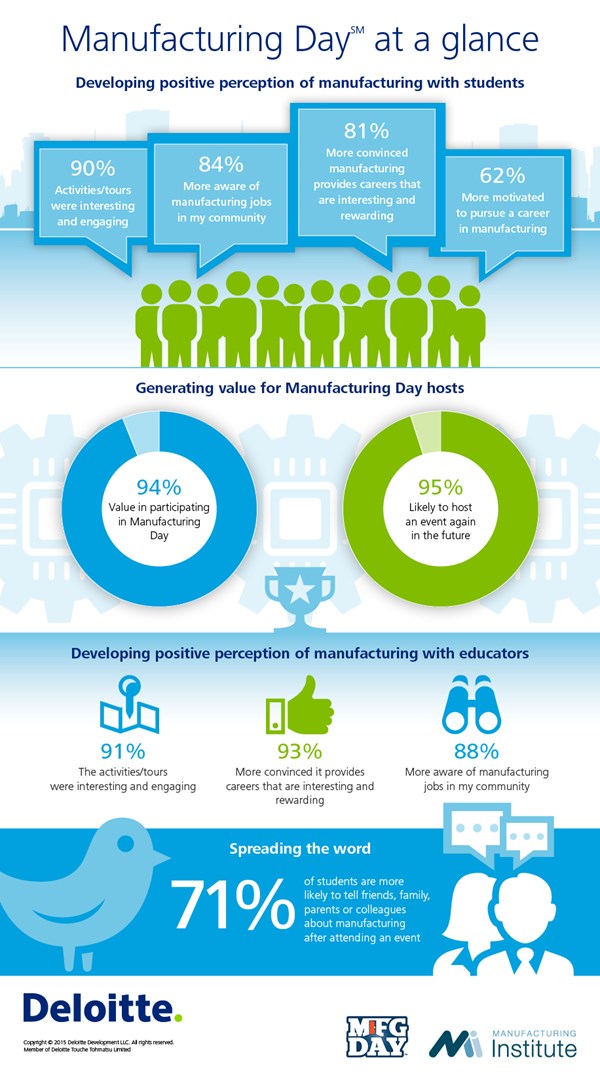#MFGDay15 Illuminates and Bridges the Manufacturing Divide
Gaps in workforce skills and public perception are nothing new to manufacturing. What is Manufacturing Day doing to help, and what happens after outreach?
Share





ECi Software Solutions, Inc.
Featured Content
View More
Autodesk, Inc.
Featured Content
View More



.png;maxWidth=45)
DMG MORI - Cincinnati
Featured Content
View More
Photo courtesy of The Manufacturing Institute.
It’s no news that U.S. manufacturing faces a challenge: growing the workforce. There are increasing calls to reach out to the community and to schools, to make manufacturing relevant to millennials, to change perceptions of what some people see as a dingy, dangerous or old-hat field of work.
To try to change perceptions and facilitate just this sort of outreach, Manufacturing Day (MFG Day)—coordinated by The Manufacturing Institute—presided over more than 2,600 events held across the United States, Canada, Mexico and Puerto Rico in 2015, reaching more than 400,000 participants. Unified on social media by the hashtag #MFGDay15, these events were hosted by manufacturers who opened their doors to students and community members to showcase modern manufacturing.
Based on a Deloitte survey of participating teachers, students, parents and employers taken after MFG Day 2015, the effort seems to be working.

Find the infographic and more detailed survey results at mfgday.com.
According to The Manufacturing Institute, the survey found that after attending MFG Day events, 81 percent of student respondents were more convinced manufacturing provides careers that are both interesting and rewarding, and 71 percent were more likely to tell friends, family, parents or colleagues about manufacturing.
Ninety-four percent of manufacturers surveyed found value in participating in the event and 88 percent are more likely to continue engaging with high schools or colleges in their area.
Illuminating the Divide
The avowed purposes of MFG Day speak to the gaps in labor skills, demographics and perception that trouble manufacturers. An earlier Deloitte study found that while 90 percent of Americans believe manufacturing is very important to national prosperity, only a third of parents on average would encourage their children to pursue a career in it.
That said, the study also found that those familiar with manufacturing were twice as likely to encourage a child to pursue a manufacturing career.
In that light, the event’s focus on getting manufacturers to engage with local communities and expose young people, their teachers and parents to modern manufacturing would seem to be the ticket to improving the odds for manufacturing’s future.
Bridging the Divide
The divide between potential machinists and established professionals often manifests as differences in age, demographics and culture. Some manufacturers may find bridging those gaps difficult. The MFG Day approach helps make it easier for event hosts to connect with the community—particularly the younger crowd—where they are. That means local venues. It also means social media.
To this end, MFG Day and its partners have put effort into providing a variety of toolkits and guides for reaching out to and capitalizing on local and trade media, social media, schools, and others. Edge Factor got involved as well as Science Channel, publishing material that local hosts and organizers could use and distribute to put manufacturing on kids’ radars.
But even if students and their parents change their perceptions of manufacturing, what’s supposed to happen then?
What Happens After Outreach
As Editor Pete Zelinski wrote recently, “One thing these outreach efforts often lack is a specific way forward. If a young person becomes interested in machining…then what should he or she prepare to do to follow this interest and proceed into this career?” In that blog, Mr. Zelinski cites a document by a professional machinist who describes his own career path and recommends concrete steps in pursuing a manufacturing career.
For other material on this topic, you may want to check out Russ Willcutt’s MMS Online blog post on drawing millennials to manufacturing or maybe the 13-part series on finding, training and retaining employees Ryan Pohl contributed to MoldMaking Technology.
To begin planning for your own MFG Day event in 2016, go to mfgday.com and access the site’s event planning resources. While you’re there, you may want to peruse Facebook, Instagram or Twitter to see what other event hosts did on these platforms in 2015.
Related Content
In Moldmaking, Mantle Process Addresses Lead Time and Talent Pool
A new process delivered through what looks like a standard machining center promises to streamline machining of injection mold cores and cavities and even answer the declining availability of toolmakers.
Read MoreWorkholding Fixtures Save Over 4,500 Hours of Labor Annually
All World Machinery Supply designs each fixture to minimize the number of operations, resulting in reduced handling and idle spindle time.
Read MoreSolve Worker Shortages With ACE Workforce Development
The America’s Cutting Edge (ACE) program is addressing the current shortage in trained and available workers by offering no-cost online and in-person training opportunities in CNC machining and metrology.
Read MoreThe Power of Practical Demonstrations and Projects
Practical work has served Bridgerland Technical College both in preparing its current students for manufacturing jobs and in appealing to new generations of potential machinists.
Read MoreRead Next
5 Rules of Thumb for Buying CNC Machine Tools
Use these tips to carefully plan your machine tool purchases and to avoid regretting your decision later.
Read MoreRegistration Now Open for the Precision Machining Technology Show (PMTS) 2025
The precision machining industry’s premier event returns to Cleveland, OH, April 1-3.
Read MoreBuilding Out a Foundation for Student Machinists
Autodesk and Haas have teamed up to produce an introductory course for students that covers the basics of CAD, CAM and CNC while providing them with a portfolio part.
Read More


































.jpg;maxWidth=300;quality=90)










